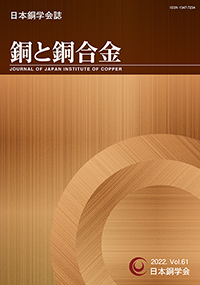Volume 61, Issue 1
Displaying 51-67 of 67 articles from this issue
Melting, Casting
-
2022 Volume 61 Issue 1 Pages 268-272
Published: 2022
Released on J-STAGE: December 14, 2022
Download PDF (1092K) -
2022 Volume 61 Issue 1 Pages 273-278
Published: 2022
Released on J-STAGE: December 14, 2022
Download PDF (1708K)
Simulation
-
2022 Volume 61 Issue 1 Pages 279-283
Published: 2022
Released on J-STAGE: December 14, 2022
Download PDF (1240K) -
2022 Volume 61 Issue 1 Pages 284-289
Published: 2022
Released on J-STAGE: December 14, 2022
Download PDF (1328K) -
2022 Volume 61 Issue 1 Pages 290-294
Published: 2022
Released on J-STAGE: December 14, 2022
Download PDF (940K)
Composite Material
-
Preparation and Thermal Conductivity of Copper Plated Carbon Fiber Dispersed Steel Matrix Composites2022 Volume 61 Issue 1 Pages 295-299
Published: 2022
Released on J-STAGE: December 14, 2022
Download PDF (1193K) -
2022 Volume 61 Issue 1 Pages 300-305
Published: 2022
Released on J-STAGE: December 14, 2022
Download PDF (1288K) -
2022 Volume 61 Issue 1 Pages 306-310
Published: 2022
Released on J-STAGE: December 14, 2022
Download PDF (1549K) -
2022 Volume 61 Issue 1 Pages 311-316
Published: 2022
Released on J-STAGE: December 14, 2022
Download PDF (1365K)
Material Development
-
2022 Volume 61 Issue 1 Pages 317-322
Published: 2022
Released on J-STAGE: December 14, 2022
Download PDF (1623K) -
2022 Volume 61 Issue 1 Pages 323-328
Published: 2022
Released on J-STAGE: December 14, 2022
Download PDF (4531K) -
2022 Volume 61 Issue 1 Pages 329-333
Published: 2022
Released on J-STAGE: December 14, 2022
Download PDF (1182K)
Product, Machine, Application development
-
2022 Volume 61 Issue 1 Pages 334-338
Published: 2022
Released on J-STAGE: December 14, 2022
Download PDF (1440K) -
2022 Volume 61 Issue 1 Pages 339-343
Published: 2022
Released on J-STAGE: December 14, 2022
Download PDF (3667K)
Inspection, Evaluation Technology
-
2022 Volume 61 Issue 1 Pages 344-348
Published: 2022
Released on J-STAGE: December 14, 2022
Download PDF (1470K) -
2022 Volume 61 Issue 1 Pages 349-353
Published: 2022
Released on J-STAGE: December 14, 2022
Download PDF (1510K) -
2022 Volume 61 Issue 1 Pages 354-358
Published: 2022
Released on J-STAGE: December 14, 2022
Download PDF (1164K)
